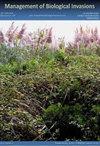外来入侵蛞蝓的摄食习性:森林和农业生态系统草食风险评估的基础
IF 1.2
4区 环境科学与生态学
Q3 BIODIVERSITY CONSERVATION
引用次数: 0
摘要
外来食草动物的入侵常常对植被造成相当大的破坏。蛞蝓是一种食草动物,当它们被引入到新的地方时,会对植被造成很大的改变。大型侵入性蛞蝓limmax maximus最近被引入日本。研究了其摄食行为,以评估其对引种地植被的潜在影响。我们进行了两个互补实验:饲养试验和DNA元条形码分析。在饲喂试验中,采用23株试验株,计算可接受度指数(AI)评价其适口性。maximus显然偏爱特定的植物;平均AI最高的是甘蓝,其次是油菜,最后是总状桑。DNA元条形码分析在野生个体的粪便中鉴定出6科植物。根据广义线性混合模型分析,L. maximus偏爱吃的植物为农作物、草本植物和无毛植物。由于本地蛞蝓和蜗牛没有表现出这些偏好,因此l.a maximus可能对本地和农业植物施加的草食压力不同于本地软体动物群落施加的压力。我们的工作表明,多种方法的结合有助于评估自然生态系统中外来食草动物的潜在风险。进一步的研究应该检查本文章由计算机程序翻译,如有差异,请以英文原文为准。
Feeding habits of the exotic invasive slug Limax maximus: a basis for risk assessment of herbivory on forest and agricultural ecosystems
Invasions of exotic herbivores often result in considerable damage to vegetation. Slugs are one of the herbivores that pose a high risk of altering vegetation when introduced to new sites. The large invasive slug, Limax maximus , was recently introduced into Japan. We examined its feeding behavior to assess potential effects on vegetation at introduced sites. We conducted two complementary experiments: feeding trials and DNA meta-barcoding analyses. In the feeding trials, we provided L. maximus with 23 test plants and calculated Acceptability Index (AI) values to evaluate palatability. Limax maximus clearly favored specific plants; average AI was highest for Brassica oleracea , followed by Lactuca indica, and Sambucus racemosa . DNA meta-barcoding analyses identified plants from six families in the feces of wild individuals. According to the generalized linear mixed model analyses, the plants that L. maximus preferred to eat were crops, herbaceous plants, and plants with glabrous leaves. Because native slugs and land snails do not show these preferences, L. maximus may exert herbivory pressure on native and agricultural plants that is different from that exerted by native molluscan communities. Our work demonstrated that combining multiple methods helps to estimate the potential risk of exotic herbivory in natural ecosystems. Additional research should examine
求助全文
通过发布文献求助,成功后即可免费获取论文全文。
去求助
来源期刊

Management of Biological Invasions
Agricultural and Biological Sciences-Ecology, Evolution, Behavior and Systematics
CiteScore
3.40
自引率
6.70%
发文量
21
审稿时长
16 weeks
期刊介绍:
Management of Biological Invasions, established in 2010 by Dr. Elias Dana, is an open access, peer-reviewed international journal focusing on applied research in biological invasions in aquatic and terrestrial ecosystems from around the world. This journal is devoted to bridging the gap between scientific research and the use of science in decision-making, regulation and management in the area of invasive species introduction and biodiversity conservation.
Managing biological invasions is a crisis science, with Management of Biological Invasions aiming to provide insights to the issues, to document new forms of detection, measurements and analysis, and to document tangible solutions to this problem.
In addition to original research on applied issues, Management of Biological Invasions publishes technical reports on new management technologies of invasive species and also the proceedings of relevant international meetings. As a platform to encourage informed discussion on matters of national and international importance, we publish viewpoint papers that highlight emerging issues, showcase initiatives, and present opinions of leading researchers.
 求助内容:
求助内容: 应助结果提醒方式:
应助结果提醒方式:


